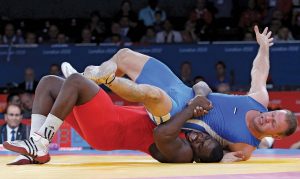There are two levels in wrestling: events that take place on the show, and events that are outside the scope of the show (in other words, are real life) but have implications for the show, such as contracts, real injuries, etc. Since real events are often used by screenwriters to include performers in storylines, the lines are often blurred and confusing.
Particular care must be taken when it comes to people performing under their real name (for example, Kurt Angle and his fictional character). The character’s actions should be viewed as fictional events, completely separate from the life of the performer. This is similar to other artists performing under a character that goes by their own name. Some wrestlers incorporate elements of their real life into their characters, even if they and their ring characters have different names.

Character / gimmick
Main articles: Face (wrestling) and Heal (wrestling)
In Latin America and English-speaking countries, most wrestlers play character roles, sometimes with personalities very different from their own. These characters (slang gimmicks) are an image designed to increase interest in a wrestler without taking into account his athletic abilities. Some of them may be unrealistic and caricatured (eg Doink the Clown) while others are more believable (eg Chris Jericho, The Rock, John Cena, Steve Austin). In lucha libre, many characters wear masks, assuming a secret identity akin to a superhero or supervillain, almost a sacred tradition.
An individual wrestler may use his real name, or a minor variation of it, throughout his career, such as Bret Hart, John Cena, and Randy Orton. Others may keep the same name throughout their career (Shawn Michaels, Ricky Steamboat) or change it from time to time to better suit the needs of the audience or company. Sometimes the character is company owned and trademarked, forcing the wrestler to look for a new look when they leave the company, and sometimes the character is owned by the wrestler himself. Sometimes a wrestler may change their real name to take ownership of their ring name (Chyna and Warrior)
. It is considered normal for fellow wrestlers to refer to each other by their stage names rather than their birth names. A character can become so popular that it appears in other works of popular culture (Hulk Hogan and El Santo) or even makes the performer famous enough to enter politics (Antonio Inoki, Jesse Ventura, Kane).
Keyfeb

Main articles: Keyfeb and Jester
Historians are not sure at what point wrestling turned from competitive wrestling to entertainment. Documentary evidence exists, however: Bret Hart recalls a “long and fascinating conversation” he had in the summer of 1981 with Lou Thesz, who told him that:
Until 1925, this business was a complete failure. In a time when Jack Dempsey knocked everyone out in a couple of rounds and Babe Ruth broke the baseball home run record, the average wrestling world title match often lasted five or six hours and ended in a stalemate. Ed “The Strangler” Lewis, Tesz’s mentor, was unbeatable, so he ended up losing the title, just to inject new blood into the business and get a good score – and then everything changed.
For decades, wrestlers have lived on with their characters, making fans aware of the industry’s believability while maintaining the popularity of both wrestling in general and the characters in particular. Maintaining the illusion of believability in wrestling circles is called “kayfabe” (English kayfabe).
There are times when something happens on the show that is not written in advance in the script, otherwise it goes beyond the character. Such moments are called “jesters” (English shoot) and are not welcome in major wrestling promotions, as this violates the integrity of the plots and destroys the concept of a keyfeb. Sometimes jester-like elements are included in wrestling stories to blur the line between representation and reality. They are known as the worked shoot. However, the vast majority of events in wrestling are pre-planned and improvised within accepted boundaries.
Gradually, the predetermined nature of wrestling became an open secret as prominent figures in the wrestling business (including World Wrestling Entertainment owner Vince McMahon) began to publicly acknowledge that wrestling was fun, not a competition. This public admission has received mixed reactions from the wrestling community, as some believe the exposure ruins the viewer experience, as happens in illusionism. Despite the public acknowledgment of the theatrical nature of wrestling, many American states still regulate wrestling like other professional sports. For example, New York State still regulates wrestling through the New York State Athletic Commission.
